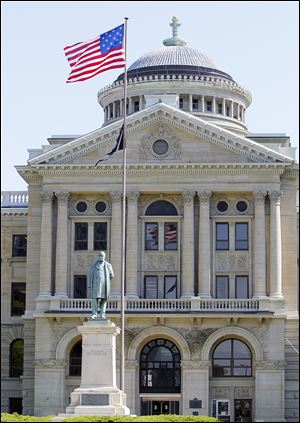
State tackles preservation of courthouses
Symposium addresses how to fund historic building projects
5/17/2014
Buildings like the Lucas County Courthouse were the topic of a two-day symposium.
COLUMBUS — Amid the success stories Friday of counties that found creative ways to restore and update their courthouses came photos of the one that got away.
Tony Logan, director of the U.S. Department of Agriculture’s Ohio Rural Development office, recalled watching streaming video of the demolition of the Seneca County Courthouse after county leaders rejected a $5 million loan his office helped to negotiate in an attempt to save the building.
“The wrecking ball rolled into town in 2012, and the area is now a vacant lot,” Mr. Logan said as a projector showed before and after photos of the 1884 courthouse in downtown Tiffin.
“These things don’t work unless they have a wide base of ‘small-p’ political support. Once these courthouses go, they’re lost forever. ... It was a very sad day.”
County commissioners, judges, architects, historic preservationists, financial experts, and others gathered in Columbus to brainstorm ideas to ensure that other mostly 19th-century courthouses in other cash-strapped counties don’t meet the same fate.
Three-quarters of Ohio’s 88 county courthouses, many of them the most visible landmarks of small rural towns, are on the National Register of Historic Places.
“The truth for several communities is that, if these courthouses are to endure for future generations, significant investments will have to be made in coming years,” said Suzanne Dulaney, executive director of the County Commissioners Association of Ohio.
“It will take more resources than county budgets on their own possess. It will not be enough to support this historic preservation with words.”
There were several success stories represented in the room.
Hancock County is nearing the end of its so-far $1.16 million upgrade and restoration of its Findlay courthouse. It has tapped court special-project funds, excess clerk of courts dollars, general tax dollars, and community fund-raising to pay the tab for a project that became even bigger once crews discovered the original ceiling that had been hidden behind the dropped ceiling of one of its courtrooms. Authorities decided to restore the historic ceiling.
“It’s such a national, local treasure, and people wanted to support it,” said Kimberly W. Switzer, county director of court services.
Voters in Wyandot County on Seneca’s southern border last week approved a property tax levy for work on their 1899 courthouse in Upper Sandusky. The six-year levy will raise about $2.2 million for roof, gutter, and dome work.
“We’re putting away $5,000 a year approximately for maintenance, so once this project is done, we’re going to maintain that up there so down the road three commissioners aren’t in the same situation 25 years from now,” said county Commissioner Steve Seitz.
Peter Ujvagi, Lucas County chief of public policy and legislative affairs, presented the idea of asking state lawmakers to earmark a specific percentage of each two-year capital budget for bricks-and-mortar projects across the state exclusively for courthouse and other local government building projects. Costs would be shared equally by the state capital budget, the county, and private philanthropic organizations.
County courthouse projects are eligible to apply for capital funding, but there are none in the most recent $2.4 billion capital budget.
“The usual capital budget route didn’t work as well as we hoped this last time,” Ms. Dulaney said.
Mr. Ujvagi argued for a change in state law to make government-owned buildings eligible for an existing state historic preservation tax credit primarily designed to combine history and economic development.
The two-day courthouse symposium was hosted by the county commissioners association, Ohio Historical Society, Ohio Supreme Court, Heritage Ohio, and the American Institute of Architects’ Columbus chapter.
Contact Jim Provance at: jprovance@theblade.com or 614-221-0496.